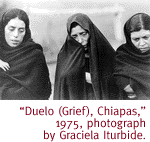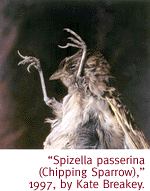

|

Etherton Gallery's Latest Exhibit Features Mexican Photographer Graciela Iturbide.
By Margaret Regan
IN 1975, THE Mexican photographer Graciela Iturbide photographed
three grieving women in Chiapas, the southernmost and possibly
poorest state in Mexico. They stand in a row, old and young, draped
in black veils, their faces contorted by sorrow. "Duelo,"
or grief, Iturbide called the picture.
Whether it's a testament to the timelessness of Iturbide's vision,
or a reminder that social conditions in Mexico change slowly if
at all, her mourning women of two decades ago could as easily
have been photographed two weeks ago. During Christmas week, a
massacre took the lives of 45 Indians in Chiapas, most of them
women and children. (Investigators have blamed the murders on
supporters of Mexico's ruling party, the PRI; the victims reportedly
were sympathetic to the reforms favored by the Zapatista rebels.)
 But Iturbide, a leading Mexican photographer now in her mid-50s,
is not a political artist or even a social documentarian. From
time to time she does do a kind of ironic commentary like that
found in her "Héroes de la patria" (1993): It
shows an impoverished Indian walking below portraits of the Mexican
heroes who were supposed to redeem his lot. But if most of her
38 works now on view at Etherton are hardly tracts about injustice,
they often provide an unsentimental picture of Mexican Indians
struggling to hang onto their cultures. A woman wearing traditional
Indian garb and toting chickens hurries anxiously along a street
in town, past a wall that just may be spattered with blood ("Los
Pollos," 1979). Carnival celebrants don elaborate masks whose
meaning may already be disappearing ("Carnaval," 1974).
A few pictures shot in Los Angeles depict the parallel Chicano
struggle. Three hostile young women glare back at the photographer
in "Rosario, Cristina and Liza, White Fence, East Los Angeles,"
1986.
But Iturbide, a leading Mexican photographer now in her mid-50s,
is not a political artist or even a social documentarian. From
time to time she does do a kind of ironic commentary like that
found in her "Héroes de la patria" (1993): It
shows an impoverished Indian walking below portraits of the Mexican
heroes who were supposed to redeem his lot. But if most of her
38 works now on view at Etherton are hardly tracts about injustice,
they often provide an unsentimental picture of Mexican Indians
struggling to hang onto their cultures. A woman wearing traditional
Indian garb and toting chickens hurries anxiously along a street
in town, past a wall that just may be spattered with blood ("Los
Pollos," 1979). Carnival celebrants don elaborate masks whose
meaning may already be disappearing ("Carnaval," 1974).
A few pictures shot in Los Angeles depict the parallel Chicano
struggle. Three hostile young women glare back at the photographer
in "Rosario, Cristina and Liza, White Fence, East Los Angeles,"
1986.
The photographer gives these pictures a sharp edge. Working
in a vein one critic calls subjective realism, she combines two
opposing impulses, one symbolic, one modernist. The latter shows
up in the spare compositions and austere backgrounds of her fine
black-and-white prints. She expresses her symbolic bent by adorning
her unflinching portraits with significant objects, especially
the flowers, masks and shrines of Mexican folk religion. Together
the two impulses give her subjects a mythic beauty, curiously
tempered by reality. The startling "Nuestra Señora
de las iguanas," 1979, is a perfect example of this trademark
mix. The lady in question wears a halo of iguanas on her head.
 In Iturbide's hands the conventional Mexican folk objects become
almost macabre. A bride in white dress and veil wears the ubiquitous
death mask of Mexican folk art; she stands in front of one of
the textured crumbling walls that Iturbide often uses as an almost-neutral
backdrop. A bare-breasted young girl poses in front of a flower-laden
shrine, but her air of eroticism and defiance leaches the expected
sweetness from the scene. So too "Angelito Mexicano"
subverts a folkloric cliché. This little girl in angel
wings has a mane of unkempt hair and a dour expression; her solid
individuality belies her angelic status. (For an instructive contrast
to Iturbide's constructed images, see Helen Levitt's realist Mexico
street scenes from the early 1940s, at the Center for Creative
Photography just until January 11.)
In Iturbide's hands the conventional Mexican folk objects become
almost macabre. A bride in white dress and veil wears the ubiquitous
death mask of Mexican folk art; she stands in front of one of
the textured crumbling walls that Iturbide often uses as an almost-neutral
backdrop. A bare-breasted young girl poses in front of a flower-laden
shrine, but her air of eroticism and defiance leaches the expected
sweetness from the scene. So too "Angelito Mexicano"
subverts a folkloric cliché. This little girl in angel
wings has a mane of unkempt hair and a dour expression; her solid
individuality belies her angelic status. (For an instructive contrast
to Iturbide's constructed images, see Helen Levitt's realist Mexico
street scenes from the early 1940s, at the Center for Creative
Photography just until January 11.)
While Iturbide often poses her subjects, she apparently also
waits for the chance moment on the street. (Henri Cartier-Bresson,
who favored the spontaneous photo, was one of her mentors, as
was the great Mexican photographer Manuel Alvarez Bravo). Iturbide's
"El Señor de los pajaros" (1984) is an elegant
vision of a passerby looking up at a flock of birds; it's a picture
both specific and universal about the enchantment of nature.
Allusions to death pepper Iturbide's works, from the skull masks
worn by holiday revelers to the dead animals handled by people
who still live close to the land. The lovely "Cementerio,"
1992, is uncharacteristically dreamy; its silent graveyard full
of painted crosses is softened by mist. The other pictures about
death are more direct, and more brutal. "Antes de la matanza"
(1992) shows a flower-bedecked goat about to be sacrificed, apparently
in a religious ceremony. In "El sacrificio" (1992),
the little slaughtered goat dangles lifeless from its killer's
hands.
 Iturbide once said that she "seek(s) to trap life in the
reality that surrounds (her)." Likewise, another artist now
showing at Etherton gives new life to dead creatures through art,
in a suite of hand-colored photographs she calls Small Deaths.
Kate Breakey, a photographer who teaches at the University of
Texas at Austin, collects tiny dead creatures that were hardly
noticed in life: geckos, butterflies, birds, flowers. She photographs
them in black and white, and enlarges their images dramatically
into prints about 3 feet square. Then she paints and pencils the
giant photographs in sumptuous color, with mesmerizing results.
Iturbide once said that she "seek(s) to trap life in the
reality that surrounds (her)." Likewise, another artist now
showing at Etherton gives new life to dead creatures through art,
in a suite of hand-colored photographs she calls Small Deaths.
Kate Breakey, a photographer who teaches at the University of
Texas at Austin, collects tiny dead creatures that were hardly
noticed in life: geckos, butterflies, birds, flowers. She photographs
them in black and white, and enlarges their images dramatically
into prints about 3 feet square. Then she paints and pencils the
giant photographs in sumptuous color, with mesmerizing results.
There's a forlorn, and very dead, whiptail lizard in "Cnemidophorus
exsanguis, Chihuahuan Spotted Whiptail," 1997. (Not only
does Breakey give her works scientific names, written on the prints
in silver ink, she composes them like standard scientific illustrations.)
The whiptail folds its little front paws over its belly and throws
its dead head back. Breakey has painted it lavishly, saturating
the background with a rich brown maroon, and delicately coloring
the lizard's fine scale pattern in gray and purply blue.
Lots of the creatures in the other 16 photos, though, no longer
look dead at all. The birds are downright monumental, all puffed
up with pride over their grand size and hyper-colored feathers.
An enormous phainopepla, pictured in profile, looks fierce. Delicate
white and yellow strokes of Breakey's pencil atop shiny black
paint suggest feathers. And her huge dead flowers, especially
a luminous white rose, are gorgeous. Like a scientist, Breakey
draws our attention to nature's microscopic patterns that too
often go unnoticed: the lizard's scales, the bird's feathers,
the petal's folds. Her work makes us more conscious of the teeming
tiny life--and death--all around us.
Photos by Graciela Iturbide, hand-colored photographs
by Kate Breakey and mixed-media works by Elizabeth Ernst
continue through Saturday, January 24, at Etherton Gallery,
135 S. Sixth Ave. Hours are noon to 5 p.m. Tuesday through Saturday,
with extended hours until 7 p.m. on Thursdays, and from 7 to 10
p.m. on Downtown Saturday Nights. For more information call 624-7370.

|
 |





